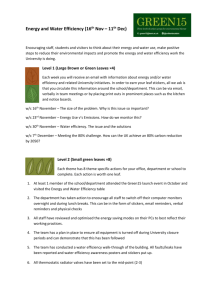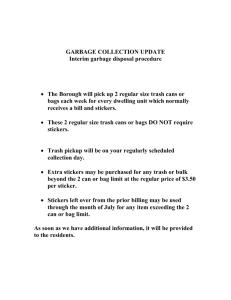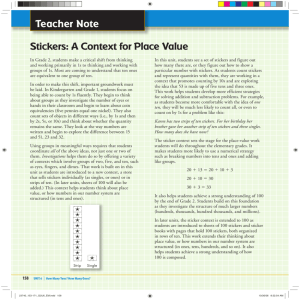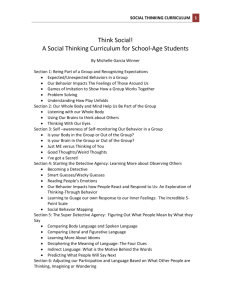sample activities here
advertisement
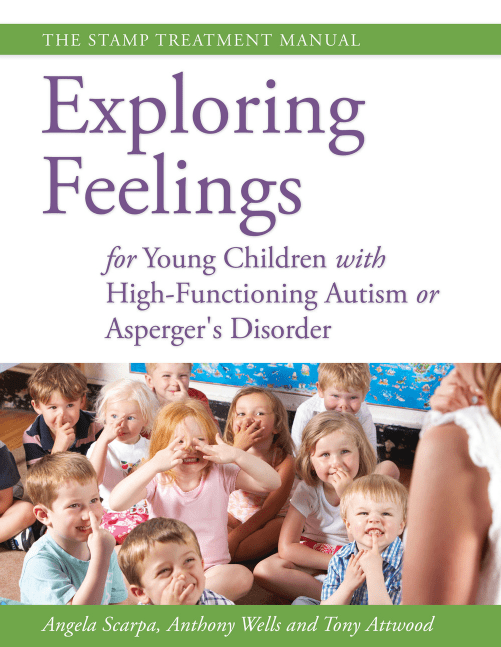
Contents Part 1: Introduction 1Overview 2 Background: Wandering in the Social–Emotional Terrain 3 Treatment Development: March toward Competency 4STAMP 5 Session Overviews 6 Research Evidence on the Effectiveness of STAMP 10 11 13 15 17 23 Part 2: Using the Manual 7 How to Use this Manual 8 General Tips 9 Suitability for the Group 10Assessments 11Troubleshooting 12 Other Practical Issues 13 List of Recommended Materials References 26 28 30 32 35 37 39 41 Part 3: Sessions and Resources STAMP Group Session 1: Exploring Positive Feelings (Happiness) STAMP Group Session 2: Exploring Positive Feelings (Relaxation) and Anger/Anxiety—Emotional Toolbox Introduction STAMP Group Session 3: Exploring Anxiety and Anger, and Physical and Relaxation Tools STAMP Group Session 4: Social Tools STAMP Group Session 5: Thinking Tools STAMP Group Session 6: Special Interest Tools STAMP Group Session 7: Appropriate and Inappropriate Tools STAMP Group Session 8: Review (Group Story and Create a Commercial) STAMP Group Session 9: Group Reward/Celebration! 44 62 79 88 97 105 115 131 Appendix A: Children’s Stories Used in STAMP Appendix B: Parent Assessments Appendix C: Child Assessments 137 138 148 52 7 List of Resources Resource 1 Resource 2 Resource 3 Resource 4 Resource 5 Resource 6 Resource 7 Resource 8 Tools for Emotional Toolbox Review of Emotional Toolbox Physical Tools Relaxation Tools Social Tools Thinking Tools Special Tools If I’m Angry and I Know It and If I’m Anxious and I Know It Songs Resource 9 My Body Resource 10 Exploring Anxiety and Anger, and Physical and Relaxation Tools—Home Project Resource Resource 11 Social Script Cards Resource 12 Social Tools Stories Resource 13 Good and Bad Thoughts Resource 14 My Thinking Tools Story Resource 15 Pictures for Fun Things Children Can Do Resource 16 Toolbox Templates Resource 17 Tool Chart Resource 18 Parent Chart Resource 19 Sample for Our Group Story Resource 20 Behavior Monitoring Sheet Resource 21 Sample Certificate 59 60 69 70 71 72 73 74 76 78 85 86 95 96 103 111 113 114 121 130 136 STAMP Group Session 1 Exploring Positive Feelings (Happiness) The primary goal for the first few sessions is to introduce different feelings. Today we will be talking about feeling happy. There are different degrees of feeling happy. The Singing and Story Time Activities are used to prime the children for thinking about happy feelings. The Ruler Game is designed to explore degrees of happiness. 1. Cool Down Time 10 minutes Supplies • • • • • Carpet squares or chairs for sitting on Butcher paper on easel or whiteboard with markers for rules Eraser for whiteboard (mitten eraser works well for children) Poster board with schedule and Velcro arrow Poster board for sticker chart Schedule/Activity Everyone relaxes with a cool down. Say to the children: The first thing we will do every week is cool down with a stretch and deep breathing. So, everyone stand up and reach to the sky like you are reaching to the sun. Now, try to catch some butterflies with one arm, then the other. Now, scoop down and pick up some flowers. Bring them up to your nose and sniff them with a deep long breath. Great job! Now that we’re cooled down, let’s sit back on our carpet squares (or chairs) and go over the group rules. Tell the children the rules of the group and explain the schedule. The rules will involve the following: • sit (in your seats or carpet squares) • look (at the speaker) 44 Session 1: Exploring Positive Feelings (Happiness) • listen (to the speaker) • calm voices/nice words • nice hands. The schedule will always be: 1. Cool Down 2. Welcome 3. Singing 4. Story 5. Activity/Game 6. Snack/Stickers and Goodbyes Tell the children: Every time you follow the rules or use the tools we teach you in this group, you can earn a star (or token, point, etc.) and swap them for stickers at the end. If we earn enough stickers, we can have a big reward when the class is over in a few weeks. What would you like your group to work for if you get enough stickers? Create a group end of program reward. The group members will suggest ideas that the entire group will work towards as reward for obtaining enough stickers at the program (e.g., if the group earns enough stickers, they can have a party). Each child can earn a sticker for each rule followed, plus other stickers for effort/good behavior during the session. The stickers can be provided immediately after each behavior throughout the session, or you can distribute them at the end of the session, depending on the fit with the group members. It is also fine to provide differential reinforcement with stickers, such that a child earns a smaller sticker for doing a good job with the rule, but can earn a big sticker if they do a fantastic job. Since they are also working towards a group reward, each individual has a goal to do their best to “follow the rules and use their tools” during the individual session, but they are also working as a group for an overall goal. After describing how the stickers will be used, ask the children: Are the stickers good for you, or for everyone? The answer is “both” because they will each get stickers, but the entire group can earn the reward at the end of the program. 2. Welcome Time 10 minutes Supplies • Butcher paper/whiteboard with markers for noting each child’s information • Digital camera • Handheld mirror (optional) 45 Exploring Feelings for Young Children with High-Functioning Autism or Asperger’s Disorder Schedule/Activity Say to the children: Now it is time for us all to find out about each other! Introductions—ask each child to tell the group about the following things: • name • age • siblings • pets • favorite food • “Where would you like to go for fun with your family?” Note: Not all of these topics need to be covered if time is running short. Take a picture of each person with a happy face. These pictures will be used to make a collage of happy faces. The group will welcome each person with enthusiasm at the beginning of each session. This sets the tone of each session. Since some children may be sensitive to having their picture taken, children can also draw pictures of faces or practice looking in the mirror and making happy faces. Save copies of these photos for use in Session 8. 3. Singing Time Supplies 5 minutes • Song written on poster with visuals • Whiteboard or butcher paper to write reasons for understanding and managing our feelings • CD of the song If You’re Happy and You Know It to sing along with and CD player (optional) Schedule/Activity Ask the children: Does everyone know why we are here? In this group, we are going to be explorers who explore different feelings. What is an explorer? An explorer is someone who searches out new things and tries to learn about them. So, we are going to be explorers of our feelings to learn how to manage them. Why do you think we would want to understand and learn how to manage our feelings? What would be good about staying calm? Get some ideas from the children, but guide them towards the following four reasons: • to feel better • to think better • to stay out of trouble • to make and keep friends. After this session, create a poster with these four reasons to post on the wall for all future sessions. 46 Session 1: Exploring Positive Feelings (Happiness) Tell the children: Today we are going to explore the feeling of being happy. To get us in the mood, let’s sing the song “If you’re happy and you know it.” Sing the song with the following words: If you’re happy and you know it, clap your hands (repeat). If you’re happy and you know it, then your face will surely show it… If you’re happy and you know it clap your hands. (Then repeat with “stomp your feet” and “shout hooray.”) Hold up the poster with visual aids so the children can follow along. Make a game out of it to see “Who can clap, stomp, or shout the loudest?” You can repeat the song several times, if time allows. Having a CD of the song and words written on a poster board is helpful for the children to follow along with. 4. Story/Discussion Time Supplies 15 minutes • • • • Book List of discussion questions with visuals Butcher paper/whiteboard and markers Handheld mirror Schedule/Activity Read a story about happy feelings (e.g., Mr. Happy by Roger Hargreaves or If You’re Happy and You Know It by Jane Cabrera). Explain to the children: Our feelings change all the time. One feeling that most people like is feeling happy. So, let’s explore the feeling of happiness. Present each of the following questions on a card with a visual aid clue to the answer. Using butcher paper or on a whiteboard, write each child’s name at the top of the column and their answers for all to see. You can also draw a figure when appropriate or illustrate their responses (like jumping up for energy). • When do you feel very happy? • How do we know when we are happy? • How does your face look? (look in handheld mirror) • What thoughts do you have? / Do you feel friendly? • How are your energy levels? / Do you feel you have the energy to do things you want? • How do you move your body? / Do you feel light or heavy? • How does your voice change? The main point to get across to the children is that their thoughts are friendly and their body feels energetic and light when they are happy. Also, point out how their faces change when they are happy (e.g., smiling). 47
